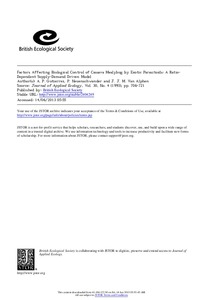| dc.contributor.author | Gutiérrez, A. |
| dc.contributor.author | Neuenschwander, P. |
| dc.contributor.author | Alphen, J. van |
| dc.date.accessioned | 2019-12-04T11:27:36Z |
| dc.date.available | 2019-12-04T11:27:36Z |
| dc.date.issued | 1993 |
| dc.identifier.citation | Gutierrez, A., Neuenschwander, P. & van Alphen, J. (1993). Factors affecting biological control of cassava mealybug by exotic parasitoids: a ratio-dependent supply-demand driven model. Journal of Applied Ecology, 30, 706-721. |
| dc.identifier.issn | 0021-8901 |
| dc.identifier.uri | https://hdl.handle.net/20.500.12478/4973 |
| dc.description.abstract | 1. A unified ratio-dependent supply-demand driven tritrophic model of the cassava (Manihot esculenta Crantz) system was compared to field data, and then used to explore the basis for the successful control of cassava mealybug (CM, Phenacoccus manihoti Mat.-Ferr.) in Africa by the exotic parasitoid Epidinocarsis lopezi (DeSantis). The causes for the failure of the related parasitoid E. diversicornis (Howard) to establish were examined. 2. Among the important findings are: (i) the functional and numerical responses of either parasitoid alone are insufficient to explain the observed dynamics of the mealybug; (ii) rainfall and its enhancement of the fungal pathogen Neozyites fumosa suppress CM numbers sufficiently during the wet season so that the parasitoid E. lopezi, with its efficient search, can regulate CM density at low levels during the dry season; (iii) weather and soil factors (e.g. nitrogen and water) affect plant growth rates directly, and CM size and number dynamics and parasitoid sex ratios indirectly; (iv) the effects of host-size dynamics on sex ratios favour E. lopezi over E. diversicornis; (v) the importance of low rates of parasitoid immigration for the successful regulation of CM is demonstrated; (vi) the higher host-finding capacity of E. lopezi enhances its dominance over E. diversicornis; but (vii) the sway of E. lopezi in cases of multiple parasitism causes the competitive displacement of E. diversicornis from the system during periods when few hosts are available and/or when weather-induced plant stress decreases host size, favouring a stronger male-biased sex ratio in E. diversicornis than in E. lopezi. 3. This modelling paradigm allows the richness of the observed biology to be incorporated with relative ease. |
| dc.language.iso | en |
| dc.subject | Biological Control |
| dc.subject | Pathogens |
| dc.subject | Cassava |
| dc.subject | Mealybugs |
| dc.title | Factors affecting biological control of cassava mealybug by exotic parasitoids: a ratio dependent supply demand driven model |
| dc.type | Journal Article |
| dc.description.version | Peer Review |
| cg.contributor.affiliation | University of California |
| cg.contributor.affiliation | International Institute of Tropical Agriculture |
| cg.contributor.affiliation | University of Leiden |
| cg.coverage.region | Acp |
| cg.coverage.region | Africa |
| cg.coverage.region | North America |
| cg.coverage.region | West Africa |
| cg.coverage.region | Europe |
| cg.coverage.country | United States |
| cg.coverage.country | Benin |
| cg.coverage.country | Netherlands |
| cg.isijournal | ISI Journal |
| cg.authorship.types | CGIAR and advanced research institute |
| cg.iitasubject | Disease Control |
| cg.iitasubject | Plant Diseases |
| cg.iitasubject | Pests Of Plants |
| cg.iitasubject | Plant Production |
| cg.iitasubject | Cassava |
| cg.accessibilitystatus | Limited Access |
| local.dspaceid | 102236 |
| cg.identifier.doi | https://doi.org/10.2307/2404249 |

